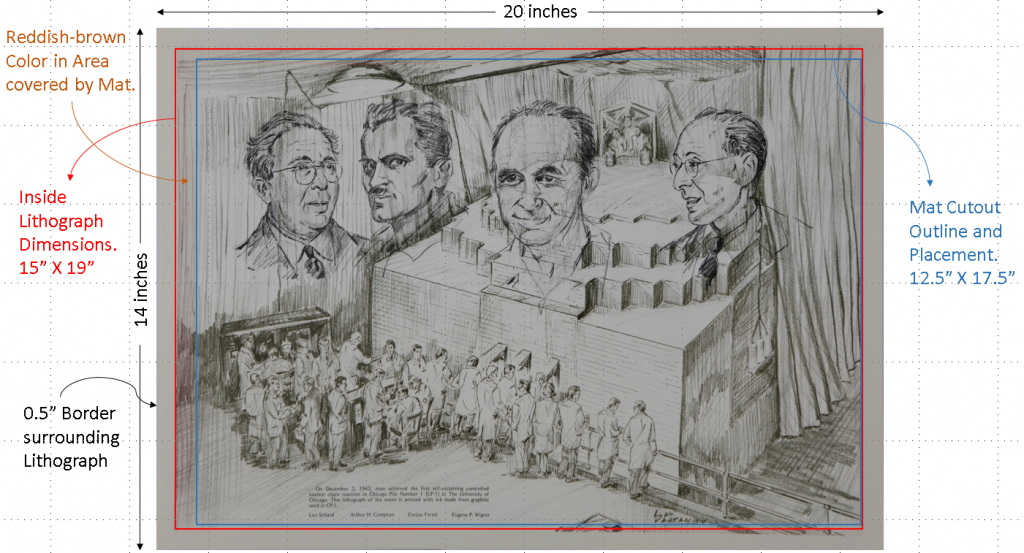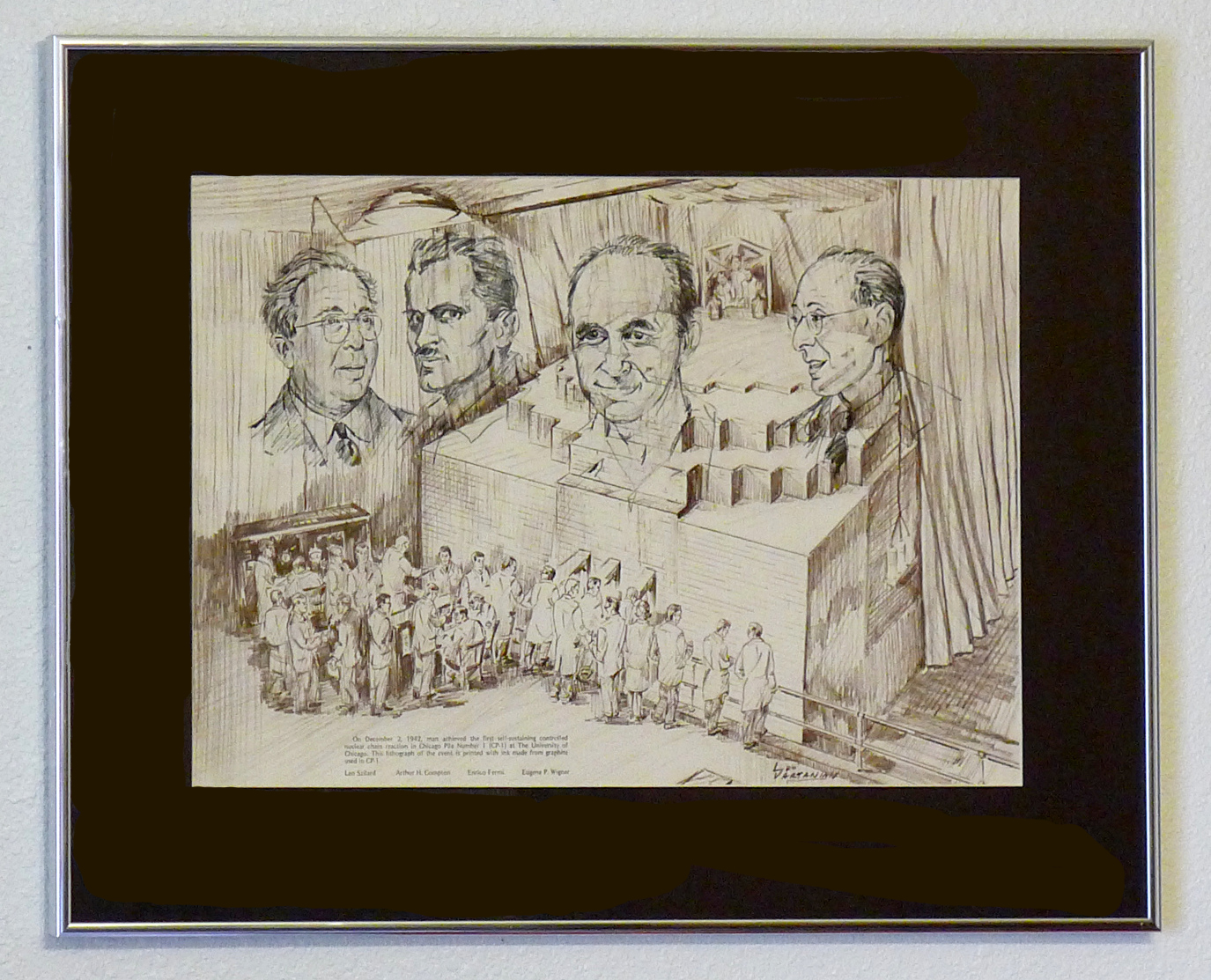by David Wargowski
Biography
Leo der Vartanian was born on August 20, 1915 in Indianapolis, Indiana, the son of Hovnan (John) der Vartanian and Eran (Ellen) Vartanian. Leo served in the U.S. Army Air Corps from 1942 to 1945 in the Pacific theatre. At the end of World War II, Leo studied art at the Chicago Academy of Fine Arts and initially became a commercial freelance artist. He was then employed as a commercial artist for the Atomic Energy Commission, the University of Chicago, and Argonne National Laboratory. Leo retired in 1979 at age 64, after a career that spanned over 30 years. In addition to being an artist, Leo held a civilian pilot’s license. Leo was a member of the Academy of Model Aeronautics and was one of the original members of the Chicago Aeronuts Model Airplane Club. Leo married Marian Talento on April 17, 1948, in Chicago. Leo and Marian had two children, Ellen and Michael. Leo died on April 7, 2011 at age 95 in Rockford, Illinois.
The Lithograph
Leo created a lithograph commemorating the first controlled and sustainable nuclear chain reaction on December 2, 1942. This successful demonstration was conducted at the University of Chicago, where the first nuclear reactor known as Chicago Pile Number 1 (CP-1) was built under the West Stands of Stagg Field. The framed lithographs were awarded by Argonne National Laboratory to distinguished employees.
The Vartanian lithograph captured this historic scientific event in vivid detail. In addition, it prominently enlarged the faces of the principal scientists involved. From left to right; Leo Szilard (conceived the nuclear chain reaction idea in 1933), Arthur Compton (head of the Chicago Metallurgical Laboratory and overseer of the CP-1 project), Enrico Fermi (leader of the team that designed and built CP-1), and Eugene Wigner (leader of the team that designed production nuclear reactors to convert uranium into weapons grade plutonium). However, the most unique aspect of this lithograph is the ink. As indicated in the lower left side of the lithograph, the ink used in the printing process was mixed with a portion of the actual neutron moderator graphite from CP-1. Even though the lithograph description does not provide a distinction between the ink used for the enlarged faces of Szilard, Compton, Fermi, Wigner, and the remainder of the rendering, other descriptions have indicated the CP-1 moderator graphite containing ink was restricted only to the printing of the enlarged four faces.
The actual date/year of the lithograph rendering is presently unknown. In addition, the lithograph was not visibly numbered. According to several internet based auctions and descriptions, approximately 30-50 prints were made. All of the lithographs discovered to date were framed using a standard 17 X 22 inch frame with a polished chrome finish. A chocolate brown colored mat was used to surround the lithograph with a cutout opening of 12.5 X 17.5 inches.
Dieter Gruen’s Vartanian Lithograph
 Dieter Gruen (left, also holding a small briquette of CP-1 moderator graphite encased in acrylic) was one of the distinguished employees of Argonne National Laboratory who received one of these framed lithographs. Dieter could not recall the year he received the lithograph, but estimates it to be at least 25 years ago. Dieter agreed to allow his lithograph to be opened in an effort to determine its actual dimensions as well as any numbering/date information that might be obscured by the matting.
Dieter Gruen (left, also holding a small briquette of CP-1 moderator graphite encased in acrylic) was one of the distinguished employees of Argonne National Laboratory who received one of these framed lithographs. Dieter could not recall the year he received the lithograph, but estimates it to be at least 25 years ago. Dieter agreed to allow his lithograph to be opened in an effort to determine its actual dimensions as well as any numbering/date information that might be obscured by the matting.
The unframed lithograph (below, right) revealed an actual paper size of 14 X 20 inches with a 0.5-inch border surrounding all four sides, providing for an actual lithograph size of 15 X 19”. This, however, presented a problem because the lithograph was larger than the cutout size (12.5 X 17.5 inches) of the mat used in the framing. As a result, a portion of the left side of the lithograph was covered by the mat. The covered (light protected) portion of the lithograph revealed its original color of reddish-brown. The lithograph image within the border cutout of the mat has faded over the years except for the enlarged four faces that remain with crisp black detail. The unframed lithograph was unfortunately not numbered or dated. In addition, the lithograph was attached to the mat using artists tape, but the glass, mat, lithograph, and frame backing was sandwiched together using plain masking tape. The masking tape deteriorated over the years, lost its adhesive, became brittle to the touch, and was easily removed. In addition, the deterioration of the masking tape caused the internal side of the framing glass to become slightly opaque, masking the detailed quality of the framed lithograph over time.
 The lithograph was re-framed using the original frame, glass, and mat. The glass was cleaned on both sides before placement. The lithograph was placed in the same location on the mat and supported using acid-free mounting corners. A new framing wire was installed, since the original aluminum wire was now severely oxidized. The lithograph was given back to Dieter, just days before his 95th birthday. Dieter was amazed by the restored detail and overall quality of the lithograph as a result of cleaning the framing glass.
The lithograph was re-framed using the original frame, glass, and mat. The glass was cleaned on both sides before placement. The lithograph was placed in the same location on the mat and supported using acid-free mounting corners. A new framing wire was installed, since the original aluminum wire was now severely oxidized. The lithograph was given back to Dieter, just days before his 95th birthday. Dieter was amazed by the restored detail and overall quality of the lithograph as a result of cleaning the framing glass.
The Vartanian CP-1 lithograph is an exciting and unique piece of atomic history. Hopefully, the missing details surrounding its date of origin, number of prints made, and location of the original rendering will be determined.





